
- Remember me Not recommended on shared computers
Forgot your password?

Signals tour 1983

By Yeshua , October 8, 2007 in Rush
Recommended Posts
I was at the Rush gig in Glasgow on Wednesday - awesome!!!
I wonder if anyone can help me I would like to know the set list for the Signals tour in 1983.
Link to comment
Share on other sites.

Fairly powerhouse opening run of songs:
The Spirit of Radio
Digital Man
Subdivisions
Vital Signs
The Camera Eye
Closer To The Heart
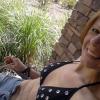
and the T4E tour too I believe.
Pick up the different stages live CD. It's the second track if I remember correctly. Awesome performance.

ReflectedLight
http://www.youtube.com/watch?v=cgZFJkraCRU
I quoted Analog kid under my highschool year book picture.
"When I leave I don't know what I hoping to find, and
I think I was 16 or 17 at the time, with 2nd row floor in front of Ged. That was my third Rush show having already PeW and MP.
Sadly those were the best seats I have ever had.

PuppetKing2112
I think Alex said in Contents Under Pressure that "Losing It" is one of those songs that was just produced in such a way so as they can never play it live. He said the same about "Different Strings" and "Madrigal."
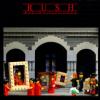
Ancient Ways
At the time I didn't appreciate how awesome that setlist is. At least I was there.

willowroolz

HamiltonYYZ
Perhaps with today's technology they could perform it live. Maybe an special concert ? And inviting Ben Mink for the violin part would be brilliant !
Quebec City 08' last show of the tour on the Plains of Abraham in front of a half million people would be a good choice.

Milton Bridge
I remember seeing them play in Edinburgh during the Signals tour when I was 17 - a fantastic set list.
We had managed to push our way down front and when 2112 hit the crowd went wild and I can remember having my feet lifted off the ground and being moved around by the force of the crowd. ( i was a bit lighter in those days

This was the tour thatI lost interest with Rush! Hated the album at the time (it will never be one of my favourites), and I thought the tour was too gimmicky, what with videos of space shuttles, and flashing red cars etc. We were told by a guy on the 'door', that the previous night one of the band had been ill, and the show wasn't great. All this coupled with the big agricultural shed at Ingleston (?) made for a poor gig.
Didn't see them again until R30 at the SECC in Glasgow. What a re-introduction to live Rush.
Ingliston was a crap venue
Losing It (along with Subdivisions) are my favorites from
Signals , touching lyrics in the same way as The Pass.

WorkingAngel
I remember that tour. Now I feel old.
This topic is now archived and is closed to further replies.
Recently Browsing 0 members
- No registered users viewing this page.
- Existing user? Sign In
- Online Users
- Leaderboard
- All Activity
- Create New...
“They had their own code… They would communicate with each other via eye contact and head movements. It was amazing how many long, nuanced phrases they could play that way”: How Rush made Signals
The trio’s ninth album was born amid tension over synths and mixes and a concern about disappointing long-term fans - but it proved to be the band’s transition into the 80s and beyond

When Rush released their ninth studio album, Signals – their final record with longtime producer Terry Brown – one thing was clear: they had no intention of making another Moving Pictures . Marking the 40th anniversary reissue in April 2023, Prog uncovered the space shuttle launch and unique Chemistry that inspired the birth of their keyboard era.
The launch of the Space Shuttle Columbia on April 12, 1981 was the biggest leap forward in the Space Race since the Moon landing 12 years earlier. This was the very first reusable spacecraft, able to orbit the planet and return safely to Earth in one piece after its mission was complete.
Several NASA employees and a group of specially invited guests had gathered at 7am in a private viewing area within the grounds of the Kennedy Space Center on Merritt Island, Florida to watch billions of dollars’ worth of technology and two flesh-and-blood astronauts be fired into orbit. And among that group of onlookers were the three members of Rush .
The Canadian trio were guests of Kennedy Space Centre deputy director Gerry Griffin, who’d given them a tour of the facility, including the assembly building, a room so vast it had its own indoor cloud system. They’d also had a cheeky go on the Space Shuttle simulator during the tour, only for guitarist Alex Lifeson – a qualified pilot – to crash the computerised craft headfirst into a swamp.
The launch of the real thing was originally scheduled to take place two days earlier but it had been delayed due to technical problems. The change of date meant that Rush had to hightail it to Florida immediately after a show in San Antonio, Texas, then head back straight after to play another show in Fort Worth. But there was no way they were going to miss this.
And so Lifeson sat with bassist/vocalist Geddy Lee and drummer Neil Peart on a blanket on the viewing area’s grass lawn, gazing over the lagoon in front of them to the launch pad a few kilometres away. As the countdown began, the already electric atmosphere began to intensify: five, four, three, two, one... Flames billowed from the shuttle’s booster rockets, a huge roar swept across the lagoon, and the Columbia lifted off.
“It was the most incredible thing I’ve ever heard,” says Alex Lifeson now, his voice still edged with awe. “It was so loud – the low end rumble of the rocket was incredible. It just screamed off in a plume of exhaust as it rose into the sky, and then it was gone into space and there was this eerie quiet. In this lagoon that was right in front of the viewing area, these dolphins came up and they started swimming in their little pattern. Here we are at the peak of human technology, and there’s such a great example of ancient nature right before us. The contrast was amazing.”
Prog Newsletter
Sign up below to get the latest from Prog, plus exclusive special offers, direct to your inbox!
As the magnitude of what they had just seen sank in, Lifeson and his bandmates glanced around at their fellow guests. That’s when they spotted some familiar faces. “We looked over and, a couple of spots to our left, Steven Spielberg and George Lucas were sitting on a similar blanket,” says the guitarist. “We didn’t know each other, but we just looked and nodded and smiled at the whole experience that we’d just had.”
Even the proximity of two Hollywood A-listers paled into insignificance next to the launch itself. Neil Peart was still processing what they’d witnessed as he boarded the plane they’d hired to get them to that evening’s gig.
“I remember thinking to myself as we flew back to Fort Worth after a couple days without sleep, ‘We’ve got to write a song about this!’” the drummer and lyricist later noted in a diary he wrote for Sounds magazine in 1982. “It was an incredible thing to witness, truly a once-in- a-lifetime experience.’
Rush did indeed write a song about what they saw on that April morning. Countdown would appear as the propulsive closing track on their ninth album, Signals , its build-and-release energy mirroring the launch of the shuttle itself. As real-life voices from the NASA control room punctuate the song, Peart’s words capture the wonder and promise of the moment. ‘This magic day when super-science/Mingles with the bright stuff of dreams,’ sings Geddy Lee, bringing the drummer’s lyrics to life.
Signals was Rush’s own space shuttle moment. A bold step into the future that saw them embracing new sounds and new technology (and in the case of Lifeson, a snazzy new wave haircut), it opened up the rest of the decade for them. The album’s shorter songs and increased reliance on keyboards and synthesisers alienated the more obdurate section of their fanbase, but Signals was ultimately the sound of a band ready for the oncoming technological rush of the 1980s.
“I guess you could stay where you are and do the same thing over and over and over again, but that’s not the kind of band we are,” says Lifeson. “Progress is important to us. We always need to go somewhere else. We always wanted to evolve.”
Few Rush albums are as representative of that desire to move forward as Signals , yet it didn’t come completely out of the blue. The shift towards shorter songs had properly begun two albums earlier, with 1980’s Permanent Waves , while synths and keyboards had been an integral part of Rush’s sound since 1977’s A Farewell To Kings .
But it was with 1981’s Moving Pictures that Rush took a big leap forward. Sleeker and less concerned with the (admittedly glorious) instrumental grandstanding of the past, it was the closest the trio had come to making a contemporary rock album.
Buried at the end of that record was a song that signposted what was to come next. With its squelching keyboards, fluttering synths and Police -esque reggae breaks, Vital Signs sounded like nothing Rush had recorded before – prog sensibilities in a new wave wrapper. But the biggest tell came via Peart’s lyrics. ‘ Everybody got to deviate from the norm,’ sang Lee, inadvertently foreshadowing Rush’s own next move.
“It was the last song we wrote on the record, and we wrote it in the studio,” the singer told Prog in 2021. “Certain albums have that one spontaneous song, and it’s funny because those types of songs end up being a precursor for some styles that we might do on the next record. Like a segue, almost. So Vital Signs really kicked us off towards Signals without us even knowing it.”
Moving Pictures was the most successful album Rush had released to that point, and an intensive, 10-month long tour followed. It was during those dates that Rush began formulating ideas for their next album. “We were touring so much that we were limited in the time we had to write for a record, so we utilised soundchecks or even days off, when Ged and I would sit down with a couple of guitars and do a little bit of writing,” says Lifeson. “But soundcheck was the best opportunity for us to throw some ideas around – we’d play a couple of songs in full, but also do a little bit of writing. I’m sure there are ancient cassettes somewhere with snippets of ideas that ended up on all our records.”
One song that emerged in nascent form from these jams was Chemistry , which would eventually become the third track on Signals . In his diary for Sounds , Peart recalled the song’s inception at some forgotten North American venue. “On this particular day in ‘Somewhere USA’ we will unknowingly write a whole song at once, each of us playing a different part,” the drummer wrote. “While Geddy plays what will become the keyboard melody for the bridge section, Alex is playing the guitar riff for the verses, and I’m playing the drum beat for the choruses. Just like that!”
Lee and Lifeson would refine the song further at the bassist’s house on the shores of Lake Simcoe, 60 miles north of Toronto. The guitarist headed up to his bandmate’s place after the Moving Pictures tour wrapped up in July 1981. He bought with him a tiny, cigarette packet-sized practice amp that he’d been given, and the pair proceeded to construct a primitive record booth by placing the amp and microphone in his guitar case. “It was our way of isolating the sound,” he says. “ Chemistry was one of the songs we worked on while I was there.”
Chemistry remains the only Rush song to feature a joint Lee/Lifeson/ Peart lyric credit. “Geddy and Alex together came up with the title and concept for the song, wrote out a few key phrases and words that they wanted to get in, then passed it along to me for organisation and a little further development,” wrote Peart in Sounds in 1982.
Another track that took shape during the band’s on-the-road jam sessions was Subdivisions , Signals ’ eventual opening track. The trio would pick the latter song up when they began mixing the live album Exit... Stage Left with longtime co-producer Terry Brown in September 1981 at the Le Studio recording facility in Morin-Heights, Quebec, 50 miles north of Montreal.
“We were getting a little bored with inactivity,” wrote Peart in his diary. “During the mixing of Exit... Stage Left there was really not much for us to do except say ‘It sounds good’ or ‘It doesn’t sound good.’” The drummer used the time to work on lyrics, including those of Subdivisions , an empathetic look at growing up in the suburbs, with all the emotional, psychological and cultural baggage that came with it.
“One afternoon as I was idly polishing my car, Alex and Ged returned from working at the little studio, set up a portable cassette player right there in the driveway, and played me the musical ideas they had come up for it,” wrote Peart. The drummer liked the tricksy, shifting time signatures and the interplay between guitar, bass and keyboards, and the three of them fashioned it into a completed song in between mixing sessions.
Subdivisions would be road-tested at shows in Europe and North America on the Exit... Stage Left tour in November and December 1981. Bootlegs from the time capture a song that’s virtually identical musically and lyrically to the finished version, though Lifeson’s jagged guitar was far more present on those early live performances. That would eventually become a bone of contention, but for now, all three members were pulling in the same direction.
At the beginning of 1982, the band decamped to Windermere Lake in Northern Ontario with Terry Brown for pre-production. The English-born Brown had co-produced every Rush album since 1974’s Fly By Night and was their unofficial fourth member. The fact that it was off season meant they could rent an entire ski resort for themselves.
“The place was completely empty – it was like The Shining ,” says Lifeson. “There was a big venue and we locked ourselves in there for a month or so and rehearsed and finished the songs for the album.”
The one thing that they emphatically didn’t want to do was make Moving Pictures II . “That would have been boring,” says Lifeson. “The style of the songs we were writing was very much of the 80s, and what was prevalent at the time. ”
Rush were as plugged into what was going on around them musically as they had been a decade earlier, except where Yes and Led Zeppelin had been their twin north stars in the early 1970s, now it was everyone from The Police, Ultravox and early U2 to Discipline -era King Crimson and UK . “There was a lot of crappy music back then too,” says Lifeson, laughing.
But while they were woodshedding the songs in that big empty winter resort, they shut out all external musical stimuli for fear of it explicitly influencing what they were doing. “Typically, the three of us seldom listened to any outside music when we were working on a record,” says Lifeson. ‘That was an unspoken rule.”
The early versions of the songs hewed close to the finished article, albeit in more bare-bones form. “The demos sounded really good, but of course lacked the sophistication of sound and performance that one fine-tunes in the studio,” says Brown. “In terms of arrangement, they didn’t change a whole lot, but in terms of production values, the vocal perspectives on Subdivisions , the unruly mob on The Weapon , and all the sound effects on Countdown were big production values that weren’t tackled in the pre-production stage.”
But even in this formative stage, it was clear that these songs were a step on from what had come before. There was a pronounced reggae feel to one new song, Digital Man , even more so than past dabblings in the genre on The Spirit Of Radio and Vital Signs . “I don’t know if any one of us was a reggae fan specifically, but it was in the air,” says Lifeson. “There was never a case of, ‘Let’s sit down and write a reggae song.’ It was just part of the mix of styles that we absorbed.”
One person who was surprised by the growing presence of reggae in Rush’s music was Terry Brown. “I was a little taken aback by the reggae/ska influence,” says the producer, “but juxtaposed to Subdivisions , Countdown , and The Weapon I felt we had a really strong record.”
Something else that was increasingly part of the mix was the growing prominence of keyboards. Lee, especially, was the band’s resident gadget-head. “The synthesiser is a wonderful thing in that it opens up so many areas of expression for people who don’t have the technique a keyboardist might have,” he told Northeast Ohio’s Scene magazine. “You really don’t need technique because with a synthesiser you can use your own technique. As long as you have a sense of how to write a melody, you can use the synthesiser to express yourself.”
Lifeson is sometimes painted as a keyboard refusenik, unhappy with the presence of synthesisers within Rush’s sound. Not so, he insists today. “I know I’ve come across as being very down on us using keyboards, but that’s not the case,” he says. “From the beginning, when we started using keyboards and bass pedals and things like that, it was a group effort. We wanted to expand our sound but we didn’t want to add any more members. I was happy to use them, I thought they did a great thing for our sound. But when they started taking priority, that’s when I started having some issues with keyboards.”
By the time Rush made their latest trek to Le Studio with co-producer Terry Brown and engineer Paul Northfield in May 1982 to record Signals , the place felt like home from home. They’d made their last two studio albums at the studio, located in the Laurentian Mountains, as well as mixing Exit... Stage Left , there.
The recording facility was built on one side of a lake; the house where Rush team were staying was on the other side. Getting from one to the other entailed walking through the woods or, even more idyllically, across the lake via canoe or rowboat. “There were huge windows overlooking the lake in the studio and windows in the control room too so you never had that feeling of being in an airtight studio, where you could never tell whether it was two in the afternoon or two in the morning,” says Brown, who Lifeson describes as “really like a fourth member – he understood our music, he was a great producer, a great engineer in his own right. He was a brother.”
They put in long hours at the studio, starting at 11 o’clock in the morning and finishing around two in the morning, with a 90-minute break for an evening meal. Any distractions were deliberately self-created. A volleyball net was set up at the house to unwind after spending countless hours in the studio.
“After we finished a session, we’d come back and we’d play volleyball until five o’clock in the morning, when the sun was coming up,” says Lifeson. “It was an opportunity for us to let off some steam, get a little exercise, drink copious amounts of brandy, smoke lots of pot.”
Brown remembers it a little differently. “Ged had an obsession with baseball so that was our focus in our downtime,” he says. “We practised on a daily basis until Ged was confident that we could tackle the girls’ team in Morin-Heights.”
Whatever sport they played away from the studio, the atmosphere during work hours was both intense and, Rush being Rush, light-hearted. “Cutting the bed-tracks was a lot of fun, but some of the vocal sessions were tense,” recalls Brown. “I remember wanting to record Ged’s vocals in the chorus of Subdivisions with the sound that you hear on the record – I felt it would inspire him to deliver the lyric in a very sincere and emotional way, but it took time to set up and he found it quite frustrating.”
Lee wasn’t the only one to be frustrated with Subdivisions . When it came to mixing the song, Lifeson noticed the stabbing guitar that had been present in early live versions was now buried under banks of Lee’s keyboards.
“We would all get behind the console and we would all have jobs – turning a knob, pushing a fader at a certain point, those sorts of things,” says Lifeson. “I was sitting there thinking, ‘I can’t hear guitar.’ I’m a very easy- going guy, but I thought, ‘This is not right.’ So I pushed that fader up. I do remember Terry turning to me and smiling and reaching over and pulling it back down. I haven’t forgotten that.”
Terry Brown remembers the polite yet borderline passive-aggressive tussle with Lifeson over the volume of his guitars, but says he wasn’t aware of any deeper differences of opinion at the time. “I’m not so sure that those differences were resolved,” he says now. “Especially since it wasn’t until after the record was released that those feelings became evident.”
The balance between Lifeson’s guitar and Lee’s keyboards was more equitable on the sparkling The Analog Kid , Peart’s semi-autobiographical exploration of adolescence. The song dated from an unlikely holiday in the British Virgin Islands at the start of 1982, where the band and Brown had spent a week on a schooner the drummer had recently purchased.
“Neil had been talked into buying this beautiful boat,” says Lifeson with a laugh. “It cost him a lot of money and he got rid of it after a year or two, but not long after he got it, he refurbished it and invited us all for holiday. We had a week on a boat, just sailing around the British Virgin Island and being pretend pirates.”
Peart recalled Lee playing him some ideas he’d been working on at home, including an electronic instrumental that would form the basis of Signals track The Weapon (the second part of the ‘Fear trilogy’ that had begun with Moving Pictures ’ Witch Hunt ). The drummer reciprocated by sharing a couple of things he’d been working on himself.
“That night as we lay at anchor in Virgin Gorda, Geddy and I went down below after dinner, and I showed him some of the work that I had been doing. I had written The Analog Kid as sort of a companion piece to Digital Man .... He told me what he liked, and what he didn’t like, and gave me some good points to go to work on. We put an end to the ‘shoptalk’ and went back to our holidays.”
Signals also featured one of Rush’s great unheralded classics, the slow-burning semi-ballad Losing It . Inspired in part by Ernest Hemingway (‘The bell tolls for thee’ is a reference to the American author’s 1940 Spanish Civil War novel For Whom The Bell Tolls ), the song was Peart’s treatise on the passage of time and the loss of youth. Its emotional pull was amplified by the spine-tingling contributions of violinist Ben Mink.
Like the members of Rush, Mink grew up in the suburbs of Toronto, though he didn’t properly get to know them until his band, FM, were invited to open the North American leg of the Moving Pictures tour in 1981. The following year Mink got a call from Geddy Lee asking if he wanted to play violin on a track on the band’s new album.
“He said, ‘We have a song that we think would work really well with a violin part,’” Mink recalls today. “They sent me a cassette of the working arrangement. It had all these ridiculous time signatures, and I didn’t really know what to make of it. But I was honoured to be asked, and I could always use a trip to Montreal.”
Mink ended up spending a few days at Le Studio, where he got to see first- hand how Rush worked. “They grew up playing together, so they had their own code and their own language,” he says. “They would communicate with each other via eye contact and head movements: ‘Let’s do this, let’s not do that.’ It was amazing how many long, nuanced phrases they could play that way.”
Mink also became part of an impromptu side-project during his time at Le Studio. The Ziv Orchestra (named in part after Lifeson’s real Serbian surname, Živojinovic) found Mink and the guitarist swapping instruments, with the former on guitar and the latter on rudimentary violin, with Peart playing along on snare drum. Their repertoire consisted of wedding band standards such as Al Martino’s Spanish Eyes and The Surfaris’ Wipe Out . “It was just us goofing around, but we did have a photo taken of us, kind of a hammed-up picture,” says Mink.
The business of recording Losing It was more serious. The band gave Mink a sense of what the song sounded like and what it was about, but essentially left him to do his own thing. Fuelled by espresso, he laid down the parts for the body of the song on a five-string electric violin before shifting to Canadian Club whisky for his solos.
“We used echo and delay to give a sense of grandeur, which I think matches the sentiment of the song,” he says. “I spent an hour or two laying down a bunch of solos, and then when it was done I went into the other room and left them alone to compile a version of what they felt were the best moments.”
“Right off the bat, what he played was just so perfect and so dripping with feeling,” remembers Lifeson. “We were all sitting in the control room when he was doing his part, and we were just blown away by it. I might have had tears in my eyes, actually.”
As with the 11th-hour addition of Vital Signs to Moving Pictures , the final piece of the Signals jigsaw fell into place in the studio. “We were pretty much done with the record, but we thought, ‘Why don’t we just throw on one more track?’” says Lifeson. That track was New World Man , the album’s first single. According to Lifeson, it was written in a couple of hours and finished within the day.
“We’d usually spend months rehearsing and writing and then months recording, so to finish a song so quickly was really unusual for us,” says the guitarist. “It was one of those songs that happened so instinctively and so suddenly.”
Like Digital Man , New World Man bore the imprint of the white reggae popularised by The Police. But Lifeson’s guitar had a brittle new wave edge to it too, the guitarist seemingly determined to leave his mark on at least one part of the album. Yet any discontent he did feel over Signals was pushed down for the greater good of the record.
“It was smooth sailing,” Lifeson says now. “We loved being together, we were in a rock band, in a recording studio, making a record – how does life get better than that?”
When Signals was released on September 9, 1982, housed in another memorable sleeve designed by their longtime art director Hugh Syme, it divided opinion. While some fans understood the band’s need to constantly move forwards, a more vocal section of their following viewed it as a betrayal of Rush’s core values.
“There was always a complaint with Moving Pictures that, ‘Oh, now they’ve become commercially successful, they’re no longer our band, they’re everybody’s band,’” says Lifeson of this pre-internet gatekeeping. “But you’ve gotta do what you’ve gotta do.” Still, the guitarist admits that he wasn’t unsympathetic to those who felt let down by the record: “I remember feeling disappointed that we had disappointed those earlier followers, because they were really important to us.”
This much was proven on the subsequent tour, which began on September 3, 1982 in Green Bay, Wisconsin and ended 109 shows later on May 25, 1983 in Edinburgh, Scotland. Though seven of Signals ’ eight songs were featured in the set ( Chemistry was dropped towards the end of the tour), they were outnumbered by tracks from the band’s older albums.
Yet there was an undeniable sense that Rush were moving into a new era, and not just because of Geddy Lee’s shiny new synth set-up. Visually, too, they were kicking it into the modern age. For Countdown , the band contacted their old friend Gerry Griffin, deputy director of the Kennedy Space Center, and told him they’d written a song inspired by the space shuttle launch they’d seen in 1982.
“He said, ‘Well, that’s incredible. Let me talk to our media department and see if we can get you some film footage of rocket launches and things like that which you can use in your show.’ And they provided all kinds of stuff, some of which had never been seen by the public before. We used it in a montage for the rear screen projection.”
Ironically, the one Signals track that wasn’t played live was the one that had Alex Lifeson welling up in the studio. “We always had one song on every record that we knew we weren’t going to play live, so we would stretch out a little bit and do things that we couldn’t replicate live,” says the guitarist. “ Losing It was that song on that record. We never intended to play it live.”
Except they did play it live, albeit 33 years after it was released. Losing It finally received its live debut at Toronto’s Air Canada Centre on June 19, 2015, halfway through the band’s R40 farewell tour. As if the poignancy of the song’s lyrics wasn’t enough, they enlisted special guest Ben Mink to recreate his electric violin parts onstage.
“It was tremendously nerve-wracking,” says Mink, who made a second appearance a month later in Vancouver. “It was supposed to be a surprise, so I couldn’t tell anybody, not even some of my closest friends. It was a little difficult for me, because my violin was way louder in my in-ear monitors than it had been in soundcheck, but from what I could tell, people were thrilled to hear it. They’d waited a long time to hear the song live. I don’t think they expected that it would ever be performed.”
Losing It was played just five times in total on the R40 tour, with Johnny Dinklage (brother of Game Of Thrones actor Peter Dinklage) standing in for Mink for the remaining performances. “It was a very powerful moment in the set,” says Lifeson. “I won’t deny being choked up most nights when we played it.”
As much as Signals marked the start of a new era for Rush, it represented the end of another. It was the last of the band’s records to be co-produced by Terry Brown. “It wasn’t an emotional decision for me, since it was the band that wanted to make the split,” says Brown now. “They needed to work with some other producers and get some other influences. Certainly producers that could accommodate a lot of keyboards,” he adds wryly.
Brown has the view that Signals came at a point where Rush were “heading for a midlife crisis, which they handled really well, and I admire them for their tenacity,” though he says he would like the chance to remix Signals with today’s digital techniques. “I’d fine-tune some of the details in the rhythm section and push the sonic footprint up a few notches,” he says.
More than 40 years after it was released, Signals remains a contentious album to some for its apparent embrace of all things 80s, though the cyclical nature of music means its synth-heavy approach sounds less dated today than the glossily produced albums they released later in the decade 80s.
Yet for others, the album has only grown in stature and significance in the years since its release. It’s a stretch to claim that Signals saved Rush at a time when traditional progressive rock was cast out in the wilderness, but, like Genesis before them and Yes after them, it brought the band in line with what was going on around them, drawing up a roadmap that helped them navigate the rest of the decade.
“I think if I had any regrets with Signals , it was in the actual production of the record, which when all was said and done, sounded a little small,” says Lifeson. “On my personal scale of importance, Signals would be somewhere in the middle – it wouldn‘t be high on my list. But it was a pivotal record for us as a band, because it continued a writing style that we’d embraced with Moving Pictures and it was a step towards what we did next.”
Permanent Waves and Moving Pictures had eased Rush into the 1980s, but with Signals they dived in headfirst. And for better or worse, they wouldn’t resurface until it was over.
Dave Everley has been writing about and occasionally humming along to music since the early 90s. During that time, he has been Deputy Editor on Kerrang! and Classic Rock , Associate Editor on Q magazine and staff writer/tea boy on Raw , not necessarily in that order. He has written for Metal Hammer, Louder, Prog, the Observer, Select, Mojo , the Evening Standard and the totally legendary Ultrakill . He is still waiting for Billy Gibbons to send him a bottle of hot sauce he was promised several years ago.
“One of the most singular, unique and influential catalogues in music history.” Every Talk Talk album ranked from worst to best
Order your limited edition Pure Reason Revolution x Prog bundle – featuring a signed lyric sheet and art print!
“I’m not very good at ignoring people who slag us off”: the story of Radiohead’s My Iron Lung, the song that changed everything for Thom Yorke & co.
Most Popular

- Collectibles & Fine Art
- Entertainment

Image Unavailable

- To view this video download Flash Player
Rush 1982 Signals Tour Concert Program Programme Book
Purchase options and add-ons, product details.
- Date First Available : March 24, 2014
- ASIN : B00J7UR55M
Product information
Technical details, additional information, product description.
Tour program from the RUSH 1982 SIGNALS TOUR. Program contains 16 pages of great photos of the band both on and off stage, nice graphics, and a discography. Measures 12" x 12". Excellent to near mint condition and comes shrinkwrapped.
Looking for specific info?
Customer reviews.
- 5 star 4 star 3 star 2 star 1 star 5 star 100% 0% 0% 0% 0% 100%
- 5 star 4 star 3 star 2 star 1 star 4 star 100% 0% 0% 0% 0% 0%
- 5 star 4 star 3 star 2 star 1 star 3 star 100% 0% 0% 0% 0% 0%
- 5 star 4 star 3 star 2 star 1 star 2 star 100% 0% 0% 0% 0% 0%
- 5 star 4 star 3 star 2 star 1 star 1 star 100% 0% 0% 0% 0% 0%
Customer Reviews, including Product Star Ratings help customers to learn more about the product and decide whether it is the right product for them.
To calculate the overall star rating and percentage breakdown by star, we don’t use a simple average. Instead, our system considers things like how recent a review is and if the reviewer bought the item on Amazon. It also analyzed reviews to verify trustworthiness.
- Sort reviews by Top reviews Most recent Top reviews
Top reviews from the United States
There was a problem filtering reviews right now. please try again later..
- Amazon Newsletter
- About Amazon
- Accessibility
- Sustainability
- Press Center
- Investor Relations
- Amazon Devices
- Amazon Science
- Sell on Amazon
- Sell apps on Amazon
- Supply to Amazon
- Protect & Build Your Brand
- Become an Affiliate
- Become a Delivery Driver
- Start a Package Delivery Business
- Advertise Your Products
- Self-Publish with Us
- Become an Amazon Hub Partner
- › See More Ways to Make Money
- Amazon Visa
- Amazon Store Card
- Amazon Secured Card
- Amazon Business Card
- Shop with Points
- Credit Card Marketplace
- Reload Your Balance
- Amazon Currency Converter
- Your Account
- Your Orders
- Shipping Rates & Policies
- Amazon Prime
- Returns & Replacements
- Manage Your Content and Devices
- Recalls and Product Safety Alerts
- Registry & Gift List
- Conditions of Use
- Privacy Notice
- Consumer Health Data Privacy Disclosure
- Your Ads Privacy Choices

musicalphabet
Rush: signals.

On September 9, 1982, “Anthem” label released “Signals”, the ninth Rush studio album. It was recorded April – June 1982, at “Le Studio” in Morin Heights, Quebec, Canada, and was produced by Terry Brown, Geddy Lee, Alex Lifeson and Neil Peart.
- Alex Lifeson – electric and acoustic guitars, Moog Taurus pedals
- Geddy Lee – vocals, bass guitars, synthesizers, arrangements
- Neil Peart – spoken word, drums, percussion, arrangements
- Ben Mink – electric violin
- Terry Brown – arrangements
- Paul Northfield – engineer
- Robbie Whelan – engineer assistant
- JVC – digital mastering
- Bob Ludwig – mastering
- Brian Lee – mastering
- Hugh Syme – art direction, graphics, cover concept
- Deborah Samuel – photography
- Kineblok Inc. – photographic colour optics
- Moon Records – executive production
Track listing:
All lyrics by Neil Peart except where noted, all music is composed by Alex Lifeson and Geddy Lee.
- Subdivisions
- The Analog Kid
- Chemistry – lyrics by Geddy Lee, Alex Lifeson, Neil Peart
- Digital Man
- The Weapon (Part II of Fear)
- New World Man
Share this:
Leave a comment cancel reply.
This site uses Akismet to reduce spam. Learn how your comment data is processed .

- Already have a WordPress.com account? Log in now.
- Subscribe Subscribed
- Copy shortlink
- Report this content
- View post in Reader
- Manage subscriptions
- Collapse this bar
- Statistics Stats
- You are here:
- Tour Statistics
- Song Statistics Stats
- Tour Statistics Stats
- Other Statistics
All Setlists
- All setlist songs ( 2423 )
Years on tour
- 2015 ( 35 )
- 2013 ( 38 )
- 2012 ( 35 )
- 2011 ( 38 )
- 2010 ( 44 )
- 2008 ( 50 )
- 2007 ( 64 )
- 2004 ( 58 )
- 2003 ( 1 )
- 2002 ( 66 )
- 1997 ( 33 )
- 1996 ( 36 )
- 1994 ( 55 )
- 1992 ( 71 )
- 1991 ( 31 )
- 1990 ( 65 )
- 1988 ( 54 )
- 1987 ( 26 )
- 1986 ( 60 )
- 1985 ( 16 )
- 1984 ( 81 )
- 1983 ( 56 )
- 1982 ( 68 )
- 1981 ( 114 )
- 1980 ( 114 )
- 1979 ( 106 )
- 1978 ( 126 )
- 1977 ( 179 )
- 1976 ( 165 )
- 1975 ( 182 )
- 1974 ( 170 )
- 1973 ( 102 )
- 1972 ( 58 )
- 1971 ( 3 )
- 1970 ( 2 )
- 1969 ( 5 )
- 1968 ( 16 )
Show all tours
- 2112 ( 76 )
- A Farewell to Kings ( 164 )
- All The World's a Stage ( 165 )
- Caress of Steel ( 88 )
- Clockwork Angels ( 72 )
- Counterparts ( 54 )
- Exit Stage Left ( 35 )
- Fly by Night ( 107 )
- Grace Under Pressure ( 81 )
- Grace Under Pressure Warm Up Tour ( 5 )
- Hemispheres ( 137 )
- Hold Your Fire ( 80 )
- Moving Pictures ( 79 )
- Moving Pictures Warm Up Tour ( 16 )
- Permanent Waves ( 98 )
- Permanent Waves Warm Up Tour ( 20 )
- Power Windows ( 71 )
- Power Windows Warm Up Tour ( 5 )
- Presto ( 64 )
- R30: 30th Anniversary Tour ( 58 )
- R40 Live: 40th Anniversary Tour ( 35 )
- Roll the Bones ( 102 )
- Rush ( 103 )
- Signals ( 108 )
- Signals Warm Up Tour ( 11 )
- Snakes & Arrows ( 113 )
- Test for Echo ( 69 )
- Time Machine ( 82 )
- Vapor Trails ( 66 )
- Avg Setlist
- Concert Map
Average setlist for tour: Signals
Note: only considered 107 of 108 setlists (ignored empty and strikingly short setlists)
- The Spirit of Radio Play Video
- Tom Sawyer Play Video
- Freewill Play Video
- Digital Man Play Video
- Subdivisions Play Video
- Vital Signs Play Video
- The Camera Eye Play Video
- Closer to the Heart Play Video
- Chemistry Play Video
- The Analog Kid Play Video
- Broon's Bane Play Video
- The Trees Play Video
- Red Barchetta Play Video
- The Weapon Play Video
- New World Man Play Video
- Limelight Play Video
- Countdown Play Video
- 2112 Part I: Overture Play Video
- 2112 Part II: The Temples of Syrinx Play Video
- Xanadu Play Video
- La Villa Strangiato Play Video
- In the Mood Play Video
- YYZ Play Video
- Drum Solo Play Video
Show Openers
Main set closers, show closers, encores played.
This feature is not that experimental anymore. Nevertheless, please give feedback if the results don't make any sense to you.
- Sep 7, 2024
- Sep 6, 2024
- Sep 5, 2024
- Sep 4, 2024
- Sep 3, 2024
- Sep 2, 2024
- FAQ | Help | About
- Terms of Service
- Ad Choices | Privacy Policy
- Songtexte.com
Rush, a 42 años de «Signals»: intentando mantener su impulso
El LP número 9 del trío canadiense de progresivo se lanzó el 09 de septiembre de 1982 y se hizo de una audiencia completamente nueva.
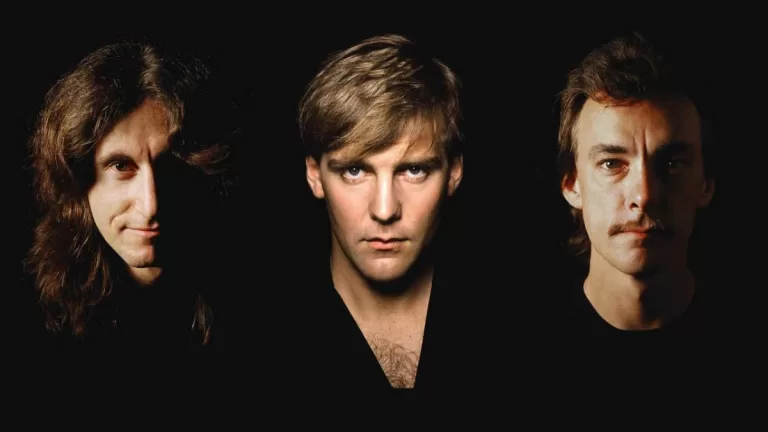
- Por Hector Muñoz
- 09 Sep, 2024. 09:14 hrs
Con su álbum de estudio número 9, «Signals», que se lanzó el 9 de septiembre de 1982, Rush enfrentó el desafío de seguir «Moving Pictures», su trabajo más destacado y con mayor resonancia artística hasta la fecha.
A comienzos de los 80, la mayoría de las bandas de rock progresivo se separaron o se acabaron por completo. Sin embargo, Rush se hacía cada vez más fuerte. «Moving Pictures» (que se ubicó en el número 3 en el Billboard 200) encontró a la banda en su forma más melódica y accesible. Eliminando las épicas longitudes de las pistas y las atmósferas indulgentes en favor de coros preparados para la arena y riffs prístinos y contundentes. Gracias a sencillos como «Tom Sawyer» y «Limelight», Rush se convirtió en un nombre familiar a principios de los 80.
Entonces, con «Signals», el trío canadiense tuvo una audiencia completamente nueva, una que esperaba no solo destreza instrumental sino también ganchos de lujo. En ese frente, «Signals» se entregó enormemente, incluso si el álbum palidece en comparación con la obra maestra previa. El álbum aterrizó en el número 10, y con el animado «New World Man», tuvieron su primer gran éxito en Estados Unidos.
Tan solo había pasado un año desde «Moving Pictures», pero en ese tiempo Rush había profundizado aún más en las texturas New Wave. «Signals» es un LP directo y brillante lleno de ángulos nítidos y limpios y superficies relucientes. Donde «Moving Pictures» se sintió perfectamente adaptado para los estadios, «Signals» fue un poco más espacioso y más atmosférico, con Alex Lifeson utilizando más reverberación de guitarra y Neil Peart adoptando un estilo de batería más texturizado y menos grandilocuente que en el pasado .
El cambio fue completamente intencional. «‘Moving Pictures’, por ejemplo, era un disco muy exuberante y con un sonido pleno. Donde las guitarras tenían pistas dobles, triples e incluso cuádruples», dice Lifeson. «Pero con Signals queríamos conseguir un sonido más angular, donde todo tuviera su lugar y hubiera un poco más de perspectiva para todos los instrumentos. La atención no se centró tanto en que la guitarra estuviera ‘aquí’ y la batería ‘allí’. Estaba un poco más repartido en diferentes porcentajes. Así que eso requirió un poco de experimentación, lo que a su vez significó más tiempo en el estudio».
El bajista Geddy Lee dijo que «‘Signals’ es definitivamente la dirección en la que hemos querido ir durante mucho tiempo». «Es algo que viene de la madurez y de haber pasado por todo el lado techno de las cosas. Hemos tocado en estos tiempos extraños y hemos hecho todos estos puntos importantes que queríamos hacer. Ahora parece que hay una mayor preocupación por la comunicación, y de eso se trata ‘Signals'».
En la misma entrevista, Alex Lifeson dijo: «Signals es un poco más accesible y todo es un poco más conciso. Se ha hecho en términos con los que todos pueden identificarse. No tienes que sentarte y repasar todo».
Sin embargo, y a pesar de que «Signals» fue un esfuerzo mucho más sencillo y con un sonido moderno, Rush aún demostró sus enormes habilidades en todo momento. El que abre el disco, «Subdivisions», es una de las pistas de la firma de la banda. Lo que indica una transición más pesada a los sintetizadores. Donde el instrumento se usó más por sus cualidades de textura en «Moving Pictures», se había convertido en un instrumento principal aquí, con las elegantes melodías de Lee en Minimoog y Oberheim OB-X.
Es uno de los mejores himnos del grupo (ganó la inducción al Salón de la Fama de los Compositores Canadienses en 2010), y uno de sus mejores matrimonios de música y letras. Las palabras de Peart son de buen gusto y conmovedoras, aprovechando una intensidad emocional e imágenes vívidas que complementan perfectamente el tormentoso estruendo de sintetizador-progresivo: «Al crecer, todo parecía tan unilateral / Opiniones proporcionadas, el futuro predeterminado / Separado y subdividido en la zona de producción en masa / En ninguna parte está el soñador o el inadaptado tan solo «.
Con las guitarras de Alex Lifeson más para la textura que los riffs ornamentados, las líneas de bajo de Geddy Lee (que parecen haber sido influenciadas significativamente por el funk y el reggae) pasan a primer plano. «Signals» es el hogar de algunas de las mejores interpretaciones de todos los tiempos del bajista. Y la producción más simple pone el músculo al frente y al centro. El veterano productor Terry Brown estaba tan molestocon la dirección de la banda en la funky «Digital Man» que inicialmente se negó a grabar la pista, y esos argumentos dieron como resultado el final de su asociación de colaboración.
No obstante, es un golpe de gracia. Con un gancho afilado como una guadaña. Y una línea de bajo tan funky y fluida que es casi risible. Mientras tanto, «The Analog Kid» encuentra a Lee explorando un estilo vocal más conmovedor en un coro verdaderamente emotivo (incluso si los versos son, para los estándares de Rush, un poco por números).
Rush seguía encontrando nuevas formas de seguir hacia adelante: sintetizadores más grandes, coros más grandes, un corazón más grande. Pero todavía no tenían miedo a la experimentación: el espacio «Losing It» se aventura en el territorio del jazz-fusión con el vertiginoso trabajo de violín eléctrico de Ben Fink y la tensa batería de Peart. Para el mundo exterior, estos cambios probablemente parecían una respuesta intencional a los cambiantes tiempos sónicos, pero para Rush, se trataba simplemente de seguir sus instintos.
«Nunca fuimos tan serios. Haces un par de cosas que pueden parecer así, y estás etiquetado sin importar lo que hagas. Siempre estás etiquetado como algo como, ‘¡Aquí está Rush, una banda de heavy metal embriagadora!’ No lo sé; la mayoría de las veces, no te importa un carajo. Te lo pasas bien, ¡y eso es todo!», dijo Lifeson a Sounds.

Contenido patrocinado
Videos relacionados.
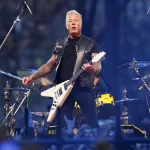
- Neil Young & Crazy Horse: a 34 años de una alta reunión con "Ragged Glory"
- John Lennon, a 53 años de "Imagine": reclamando su legado

#FuturoPQN — "En el chat de Luis Hermosilla con Ángela Vivanco hay mensajes que fueron borrados selectivamente"

música — "The Beatles: Rock Band" cumple 15 años: una nueva generación para la Beatlemanía

Chile — ¿Dónde y a qué hora ver en vivo, online y por streaming todos los partidos de la fecha 8 de las Eliminatorias de la Conmebol?

Iron Butterfly — Iron Butterfly: estas son sus 10 mejores canciones, según Futuro

música — The Legend Of Zelda Music Symphony en Chile 2024: Fecha, lugar y venta de entradas para el concierto

David Bowie — Muere Herbie Flowers, legendario bajista que trabajó con David Bowie, Elton John, Paul McCartney y muchos más

música — R.E.M. y "New Adventures in Hi-Fi": cerrando una era

música — Otis Redding: estas son sus 10 mejores canciones, según Futuro

Colin Greenwod — ¿Una buena señal? Colin Greenwod revela que Radiohead ha vuelto a ensayar juntos

música — Neil Young & Crazy Horse: a 34 años de una alta reunión con "Ragged Glory"

música — Rush, a 42 años de "Signals": intentando mantener su impulso

Navigation menu

- Visit Our Blog about Russia to know more about Russian sights, history
- Check out our Russian cities and regions guides
- Follow us on Twitter and Facebook to better understand Russia
- Info about getting Russian visa , the main airports , how to rent an apartment
- Our Expert answers your questions about Russia, some tips about sending flowers

Russian regions
- Arkhangelsk oblast
- Kaliningrad oblast
- Karelia republic
- Komi republic
- Leningrad oblast
- Murmansk oblast
- Nenets okrug
- Novgorod oblast
- Pskov oblast
- Vologda oblast
- Cherepovets
- Map of Russia
- All cities and regions
- Blog about Russia
- News from Russia
- How to get a visa
- Flights to Russia
- Russian hotels
- Renting apartments
- Russian currency
- FIFA World Cup 2018
- Submit an article
- Flowers to Russia
- Ask our Expert
Vologda Oblast, Russia
The capital city of Vologda oblast: Vologda .
Vologda Oblast - Overview
Vologda Oblast is a federal subject of Russia, part of the North-Western Federal District. Vologda is the capital city of the region.
The population of Vologda Oblast is about 1,139,500 (2022), the area - 144,527 sq. km.
Vologda oblast flag
Vologda oblast coat of arms.
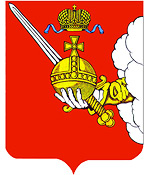
Vologda oblast map, Russia
Vologda oblast latest news and posts from our blog:.
20 November, 2021 / Saint Sophia Cathedral in Vologda .
26 January, 2021 / Ferapontov Monastery - a unique sight of the Russian North .
17 January, 2021 / Summer in Veliky Ustyug - the birthplace of Father Frost .
8 January, 2021 / The Galsky Estate in Cherepovets .
8 December, 2020 / The Brianchaninovs' Estate in Vologda Oblast .
More posts..
History of Vologda Oblast
In the 5th-7th centuries AD, the development of this territory by the Slavic population began, which entailed the assimilation of the local Finno-Ugric tribes. The first Slavic colonists of the Vologda region were the Krivichi. In 862, the town of Beloozero was founded. This area became the arena of rivalry between the Novgorodians, who founded the towns of Veliky Ustyug, Vologda, Totma, and the Vladimir princes, who gradually subdued the region.
In 1207, this region was included in the Rostov principality, from which, in 1238, the Belozersk principality was separated. In the era of civil strife, the region was again the arena of rivalry between the Novgorod Republic, Tver and Moscow principalities. In 1273, the Tver prince Svyatoslav Yaroslavich plundered and burned Vologda. In 1352, the plague killed most of the population of Beloozero and the town itself was moved to the southern shore of Beloye Lake.
In 1389, after the Battle of Kulikovo, the Belozersk principality became part of the Moscow principality. In the 14th century, the Kirillo-Belozersky Monastery was established. In the 15th century, the Belozersky Kremlin was built. The Vologda region (mainly Velikiy Ustyug) became a foothold for Moscow expansion to the north-east and east, to the territory of Ugra (1465), Perm Territory (1472) and Vyatka (1489).
Since 1567, for three and a half years, Ivan IV often lived in Vologda, watching the construction of the fortress and the stone cathedral. The Vologda lands were of great importance in the policy of Ivan IV. A number of northern towns were included in the oprichnina. A significant place in the plans of Ivan the Terrible was occupied by Vologda, which was a kind of “gateway” to the White Sea, the Trans-Urals, Western Siberia, and Europe.
More Historical Facts…
In 1612, during the Time of Troubles, Vologda was again plundered, a lot of churches and other buildings were burned. In the 16th-17th centuries, Vologda occupied a special place in the establishment of trade relations with foreign countries. Being a convenient transit point, it attracted the attention of Dutch, English merchants.
At the turn of the 17th-18th centuries, Peter the Great paid special attention to the lands of the Russian North. He repeatedly stayed in Vologda, in the house of the Dutch merchant Gutman. In the 19th century, this stone building became the house museum of Peter I. Today, the exposition of the museum includes his clothes (caftan, pants-culottes) and posthumous mask, A. Menshikov’s cup, numerous items that characterize the era of Peter the Great.
The construction of St. Petersburg and the development of trade on the Baltic Sea significantly reduced the importance of Vologda, leaving the town away from new trade routes. In the 18th century, the Vologda gubernia (province) was created.
Most of the towns of the present Vologda region was formed during the Catherine’s administrative reform: Vytegra in 1773, Kirillov in 1776, Cherepovets in 1777, Gryazovets, Kadnikov and Nikolsk in 1780. The absence of large-scale construction of modern buildings and large enterprises has allowed them to preserve the historical appearance and spirit of the past epochs. Today, in many towns of the region, whole blocks of wooden houses decorated with carvings have survived. Some small towns are recognized as historical monuments of national importance.
Since the beginning of the 19th century, the development of lacework began. Vologda lace enjoyed great popularity, its fame quickly crossed the borders of Russia. The products of the Vologda lace-makers were highly appreciated at the Paris, Brussels and other international exhibitions.
With the opening of the shipping channels, which linked important economic centers of the country, trade moved from Vologda to Rybinsk. The significance of Vologda as a commercial center decreased. The turning point to the new economic recovery happened in the 1860s. The construction of railways, the emergence of the steam fleet had a significant impact on the development of the Vologda region.
In 1872, a railway communication between Vologda and Yaroslavl was opened, in 1898 - with Arkhangelsk, in 1905 - with St. Petersburg and Vyatka. The city, lying on the banks of the navigable river, was also in the center of the intersection of important railroads. In 1881, the first dairy factory in the Russian Empire was opened in the region. Quite quickly, the brand “Vologda butter” gained great popularity.
In 1918, for 5 months, Vologda became the “diplomatic capital of Russia,” a place where embassies and missions of the 11 largest countries of the world were located. September 23, 1937, Vologda oblast was formed in its present borders.
During the Second World War, military operations were not conducted in the territory of the Vologda region. That’s why the local monuments of the cultural and historical heritage were not damaged or destroyed.
In 1955, Cherepovets became a major center for the production of cast iron on the basis of rich deposits of iron ores of the Kola Peninsula. Also the largest chemical enterprise in the country producing fertilizers was opened in Cherepovets.
This powerful industry, built in Cherepovets after the war, helped the Vologda region, even in times of crisis, to remain one of the most prosperous territories in Russia. Today, every fifth ton of Russian rolled metal is produced in Cherepovets. JSC “PhosAgro-Cherepovets” is the largest producer of phosphorus-containing fertilizers, phosphoric and sulfuric acids in Europe.
Landscapes of Vologda Oblast - the Russian North
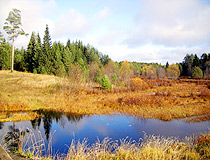
Golden autumn in Vologda Oblast
Author: Sergey Zubov
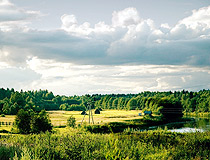
Summer in the Vologda region
Author: Michail Gordeev
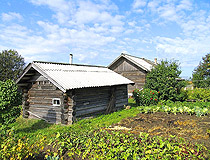
Russian dacha in the Vologda region
Author: Leonid Mach
Vologda Oblast - Features
Vologda Oblast is located in the northeast of the East European Plain. The climate is moderately continental with long, moderately cold winters and relatively short warm summers. The average temperature in January is about minus 12 degrees Celsius, in July - plus 17 degrees Celsius.
This region is rich in water resources. There are about 4,000 lakes. In the south-west there are the Sheksna and the Rybinsk reservoirs, in the west - the lakes of Beloye, Kubenskoye and Vozhe. Onega Lake in the north of the region is connected with the Volga by the Volga-Baltic waterway.
The main natural resources are timber and fresh water. Also there are deposits of peat, salt and mineral water. About 12% of the territory is covered with swamps.
The largest cities and towns of Vologda Oblast are Cherepovets (309,400), Vologda (306,600), Sokol (35,700), Veliky Ustyug (30,800).
This region is an important transport hub of Russia connecting the European part of the country with the Urals and Siberia. The federal highway M8 “Kholmogory” (Moscow-Yaroslavl-Vologda-Arkhangelsk) passes through the territory of Vologda oblast.
The rich history of the Vologda region, as well as the high degree of preservation of historical monuments and even historical towns contribute to the development of tourism.
Vologda Oblast - Economy
The main branch of local industry is ferrous metallurgy. The commodity structure is determined primarily by the production of industrial giants - enterprises of ferrous metallurgy, chemistry, mechanical engineering, woodworking: Severstal, Cherepovets Steel Rolling Plant, Cherepovets Metalwork Plant, PhosAgro-Cherepovets, Vologda Bearing Plant, Sokol Woodworking Plant.
The leading branch of agriculture is dairy farming. The region exports significant amounts of grocery goods: milk, poultry, meat, the famous Vologda butter of the Vologda Dairy Plant.
Some traditional artistic crafts have survived to this day: the Vologda lace, the largest center of lacework in Russia - Snezhinka enterprise; unique crafts of Veliky Ustyug - Shamogodskaya carved birch bark and silvering.
Vologda Oblast scenery
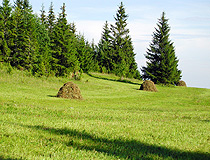
Harvesting of hay in Vologda Oblast
Author: Vladimir Shchipin
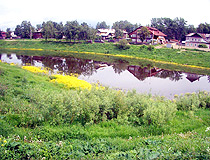
Country life in the Vologda region
Author: Antushev Vladimir
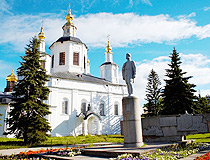
Church in Vologda Oblast
Author: Alexander Lukin
Tourism in Vologda Oblast
Vologda Oblast has a rich cultural and historical heritage. On the territory of the region there are more than 700 historical and cultural monuments. Most of the tourists visit Vologda, Kirillov district and Cherepovets. Vologda is one of the main centers of wooden architecture of Russia, distinguished by its style diversity - from classicism to modernity.
The Ferapontov Monastery with frescoes of Dionysius is included in the UNESCO World Heritage List. The ensemble of the Kirillo-Belozersky monastery is on the State list of especially valuable objects of the cultural heritage of the peoples of the Russian Federation and is one of the most visited places by tourists.
There are interesting urban ensembles in Vologda, Belozersk, Kirillov, Ferapontovo, Totma (which has its own school of church architecture), and Ustyuzhna.
Cherepovets is the birthplace of the artist V.V. Vereshchagin and his brother N.V. Vereshchagin, who invented the recipe of famous Vologda butter. There is a museum in their former estate. Near Cherepovets there is a museum of the poet Igor Severyanin, and in Nikolsky - the house of the poet Nikolai Rubtsov.
The natural attractions of the Vologda region include Darwin State Reserve, the national park “Russian North” in Kirillov district. Hunting and fishing tourism is also popular, there is a good base for the development of so-called rural tourism.
Other places of interest include the town of Vytegra (Onega petroglyphs), the villages of Sizma and Nyuksenitsa (ancient spiritual rites), Ustye - the center of boat craftsmanship, Gryazovets - an old merchant town with estates and parks, Tarnoga - famous for the production of honey, Veliky Ustyug - the birthplace of Father Frost.
The Vologda region as a part of the Russian North managed to preserve a significant number of monuments of the ethnic heritage of the Russian people (songs, legends, epics, chronicles).
Vologda oblast of Russia photos
Old churches of the vologda region.
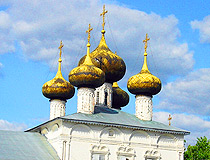
Orthodox church in Vologda Oblast
Author: Kolcow Oleg
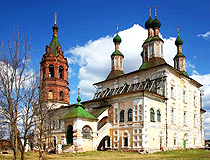
Cathedral in the Vologda region
Author: Kuzovkov N.
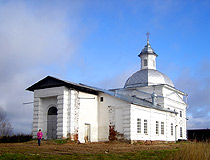
Pictures of Vologda Oblast
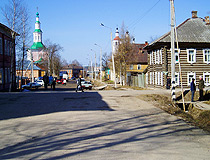
Totma - a small town in Vologda Oblast
Author: Aleck Sander
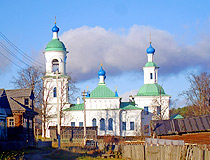
Author: Alexandr Popov
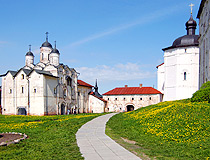
Monastery in Vologda Oblast
Author: Roberto Ribotta
- Currently 2.88/5
Rating: 2.9 /5 (217 votes cast)

COMMENTS
Date Location Venue; April 1, 1982: Little Rock, Arkansas: Barton Coliseum: April 2, 1982: Jackson, Mississippi: Mississippi Coliseum: April 3, 1982: Monroe, Louisiana
1982 - "Music Making Contact" 19821209Live on the Signals Tour from Nassau County Coliseum, New York 9 Dec 198201 The Spirit Of Baseball 0:5202 Tom Sawyer 05...
As demonstrated in numerous recordings, Rush had fun this tour, often changing the lyrics to some of the older songs such as "The Spirit of Baseball" and "The Plumbers of Syrinx" (with Lerxst adding additional vocals). Intro (Three Stooges theme first used) The Spirit of Radio. Tom Sawyer. Freewill. Digital Man.
Signals (Rush album)
Rush did indeed write a song about what they saw on that April morning. Countdown would appear as the propulsive closing track on their ninth album, Signals, its build-and-release energy mirroring the launch of the shuttle itself. As real-life voices from the NASA control room punctuate the song, Peart's words capture the wonder and promise ...
Share your videos with friends, family, and the world
Rush Signals Tour shows and interviews sorted by chronological order.
Tours | Rush.com ... Tours
Use this setlist for your event review and get all updates automatically! Get the Rush Setlist of the concert at Joe Louis Arena, Detroit, MI, USA on November 8, 1982 from the Signals Tour and other Rush Setlists for free on setlist.fm!
Watch the unboxing video for 'Signals-40th Anniversary', coming April 28,HERE The Signals 40th Anniversary releases are available at Rush Backstage now —Exclusive to Rush Backstage is the Super Deluxe Box Set with 8 printed lyric sheets, originally hand-drawn by Neil Peart, along with exclusive merchandise, PRE-ORDER HERE On April 28th, UMe/Mercury and Anthem Records continue the ...
Rush Concert History. Rush was a Canadian rock band formed in 1968 in Toronto, that was comprised primarily of Geddy Lee (bass, vocals), Alex Lifeson (guitar), and Neil Peart (drums, percussion, lyricist). The band was formed in Toronto in 1968 by Lifeson, drummer John Rutsey, and bass guitarist/vocalist Jeff Jones, who was immediately replaced ...
Get the Rush Setlist of the concert at Spectrum, Philadelphia, PA, USA on December 14, 1982 from the Signals Tour and other Rush Setlists for free on setlist.fm!
Product Description. Tour program from the RUSH 1982 SIGNALS TOUR. Program contains 16 pages of great photos of the band both on and off stage, nice graphics, and a discography. Measures 12" x 12". Excellent to near mint condition and comes shrinkwrapped. Brief content visible, double tap to read full content.
On September 9, 1982, "Anthem" label released "Signals", the ninth Rush studio album. It was recorded April - June 1982, at "Le Studio" in Morin Heights, Quebec, Canada, and was produced by Terry Brown, Geddy Lee, Alex Lifeson and Neil Peart. Personnel: Alex Lifeson - electric and acoustic guitars, Moog Taurus pedals Geddy Lee - vocals, bass guitars, synthesizers,…
Rush (103) Signals (108) Signals Warm Up Tour (11) Snakes & Arrows (113) Test for Echo (69) Time Machine (82) Vapor Trails (66) Songs; Albums; Avg Setlist; Covers; With; Concert Map; Average setlist for tour: Signals. Note: only considered 107 of 108 setlists (ignored empty and strikingly short setlists) Setlist. share setlist The Spirit of ...
Rush Signals 1982 Tour ProgramVintage and Original OwnerBought at Rush/John Butcher Axis Concert at Pittsburgh Civic Arena 4/4/1983. Close. Explore. New & Popular; ... Rush Signals 1982 Tour Program. Used - Very Good. Price $30. Free Shipping. This listing has ended. View similar gear from other sellers on Reverb. View similar gear.
Rush 1982 Signals Concert Tour Program Book! Sold on 10 May 2017 Price guide for collectable Vinyl Records, CDs, Cassettes, Reel-to-reel tapes, 8-Track cartridges, MiniDiscs and more!
Nassau Coliseum, Uniondale, New York, USADecember 9, 1982A very nice, clear audience recording from the beginning of the Signals tour. This concert is near ...
Con su álbum de estudio número 9, «Signals», que se lanzó el 9 de septiembre de 1982, Rush enfrentó el desafío de seguir «Moving Pictures», su trabajo más destacado y con mayor resonancia artística hasta la fecha. A comienzos de los 80, la mayoría de las bandas de rock progresivo se separaron o se acabaron por completo.
Located about 470 km north of Moscow, it is one of the Russian cities with a particularly valuable historical heritage. The population of Vologda is about 306,600 (2022), the area - 116 sq. km. The phone code - +7 8172, the postal codes - 160000-160901. Local time in Vologda city is September 3, 2:31 am (+3 UTC).
Vologda is a historical city in the Russian north and capital of Vologda Region. Vologda in famous for its churches, monasteries and old wooden houses.
Gertsena, 27, ☏ +7 8172 78-78-25, fax: +7 (8172) 75-33-13, [email protected]. This business-class hotel is centrally located, easily found while driving, and newly built. Rooms are comfortable, 4 stars are claimed, at least 3 stars are really delivered. Free Wi-Fi in rooms and lobby. single 3,400 - 4,600 руб, double 3,800 - 5,000 ...
Vologda Oblast is located in the northeast of the East European Plain. The climate is moderately continental with long, moderately cold winters and relatively short warm summers. The average temperature in January is about minus 12 degrees Celsius, in July - plus 17 degrees Celsius. This region is rich in water resources.